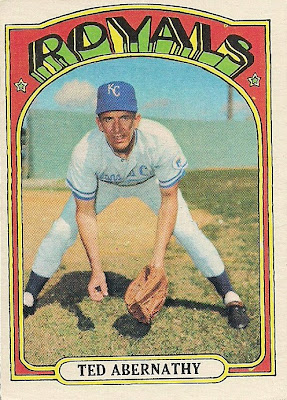Green grass is an oasis in a big city. I'm sure I'm not the first person to say that. It's no wonder that urban dwellers gravitate toward parks and baseball fields with all the depressing concrete surrounding them.
Over the years, with the rise of new and newer ballparks, we've become accustomed to our cities' well-manicured, gloriously green ballfields created by well-schooled groundskeepers. Fancy shapes mowed into the turf don't even faze us anymore. In fact, I'm quite sure some of those ritzy people in the enclosed skyboxes demand it.
We are so used to green grass and so thrilled by it that we forget how it once was:
I've shown this card before. The photo apparently was taken during the famous Grass Blight that hit the southeast in 1971.
The Expos cards in the 1972 set are filled with pictures of long-neglected lawns.
Brown grass and patchy spots everywhere. It's terribly shocking to modern fans who demand nothing less than immaculate ground conditions. Throw some chlorophyll on that thing!
You probably can tell that both of these photos were taken in the same spot. The same poles/trees are in the background at right. The same tall, green wall/fence is at left.
There is a better look at the green fence -- and not enough green on the ground.
I don't imagine that any of these photos were taken on the actual field. Lawn standards may not have been up to the fuss-budget ways of today, but I'm reasonably sure they were playing on non-brown lawns in the early 1970s, even during spring training.
It's likely the photographer set up shop somewhere on the sidelines, perhaps near a parking lot or behind the stands.
But this one threw me. Is that a BASE in the background? Please don't tell me that Ron Fairly is posing in the outfield. Was there a drought in West Palm Beach, Fla., that year?
The Expos and Braves shared the same spring training site in West Palm Beach (Municipal Stadium) from the 1960s into the late 1990s.
So I looked at a few Braves cards from the '72 set that featured photos from spring training.
More brown grass. Fortunately, Ron Herbel doesn't seem to be anywhere near the stadium.
There you see some more brown-ness for the Braves.
So the questions remain: Did the West Palm Beach site have grooming issues? Was there a water ban in town? Was it really hot in Florida in 1971? Did people just not care as much about what fields looked like then? Did people just not care as much about spring training then?
I'm guessing someone from 1971 would say, "why are you asking these questions -- you got some obsession with green grass?"
Yes. Yes I do. It's very important to us in 2013.
Let's look at another team that didn't care about grass in 1971:
The Royals played in Fort Myers, Fla., during the 1970s and that's a lot of dirt behind Mr. Abernathy.
That blue wall is featured often on 1972 Royals cards. Let's get a closer look.
There you go. And my goodness, it looks like you need some Turf Builder there.
I was surprised to see that the wall is actually the outfield wall. You can see the marker over Buck Martinez's left shoulder.
Perhaps there was only the remnants of a dirt warning track back then. Perhaps they just didn't care about those things then. Go ahead, slam into the wall. We'll scrape you up later.
Cookie gives you a look at foul territory. That field looks like some of the Little League fields from when I was a kid. A nicer looking Little League field, of course, but with apparently the same sort of budget for tending to fields.
Without ever living in Florida or knowing what baseball was like in the early '70s, I'm assuming that at this time, spring training was just a site to get the players in shape. It hadn't become as much of an event for fans as it is now. It wasn't a money-maker. People weren't as obsessed with everything being pretty.
You can see that the patchy grass syndrome extended to the most storied teams in baseball:
The Red Sox.
The Yankees.
The Dodgers. (Ray Lamb is actually wearing a Dodgers uniform/cap, airbrushed as an Indians get-up.
That's Vero Beach for crying out loud!
But whatever the reasons, I kind of like the "what-the-hay" look of the grass. As a homeowner myself, I keep the grass tidy and somewhat green. But I've never flagged down the Chem-Lawn truck in the spring or flipped out over the brown patches in August. Nature's going to do what it do. It's just grass.
I like seeing beautiful green when I walk into a stadium just as much as everyone else though. And I'd be horrified if I saw anything else.
Green grass is important on a ballfield.
Maybe more than ever.















Comments
Lots of MLB and NFL teams had their grass ripped out and they were playing on astro turf at the time.